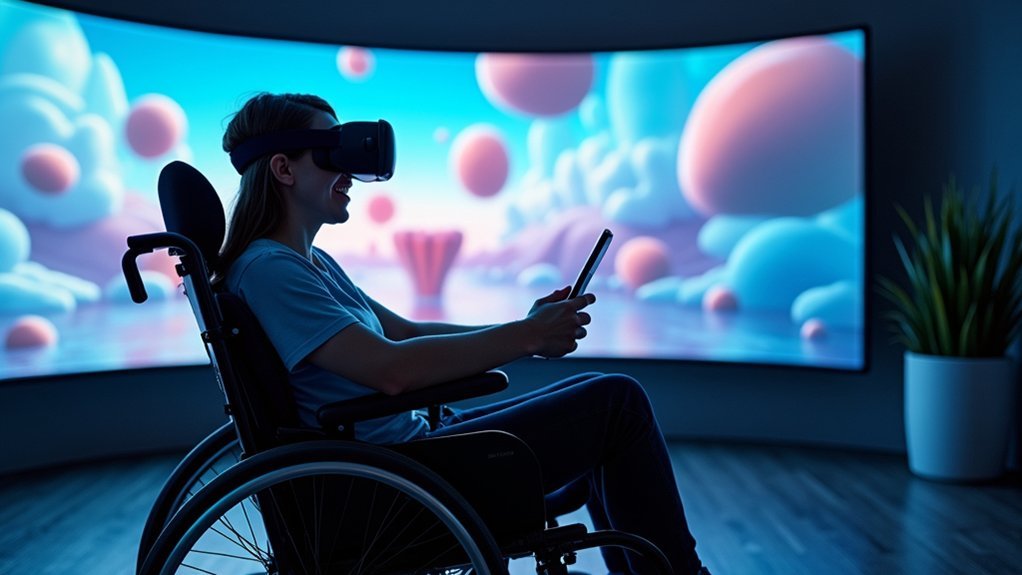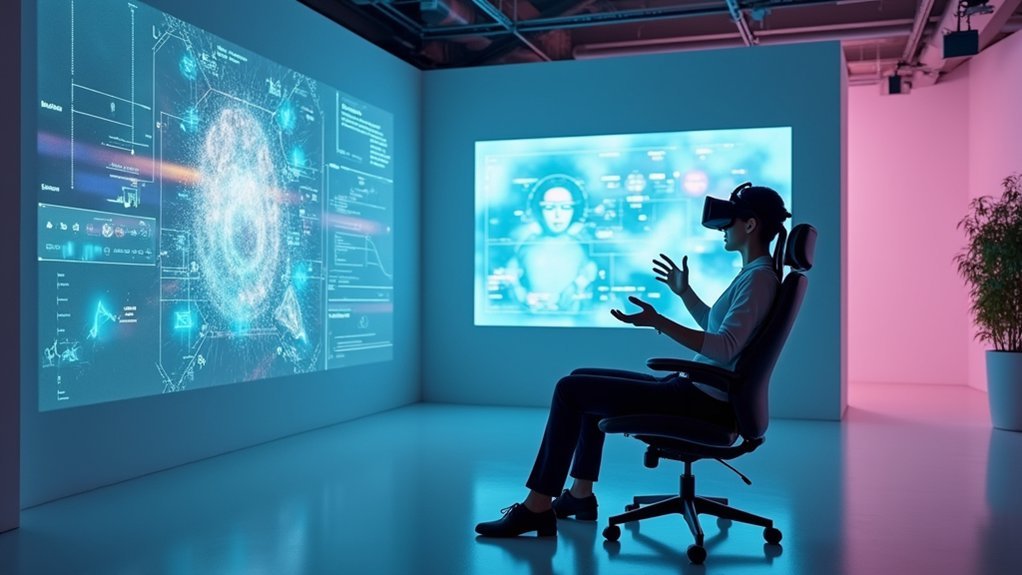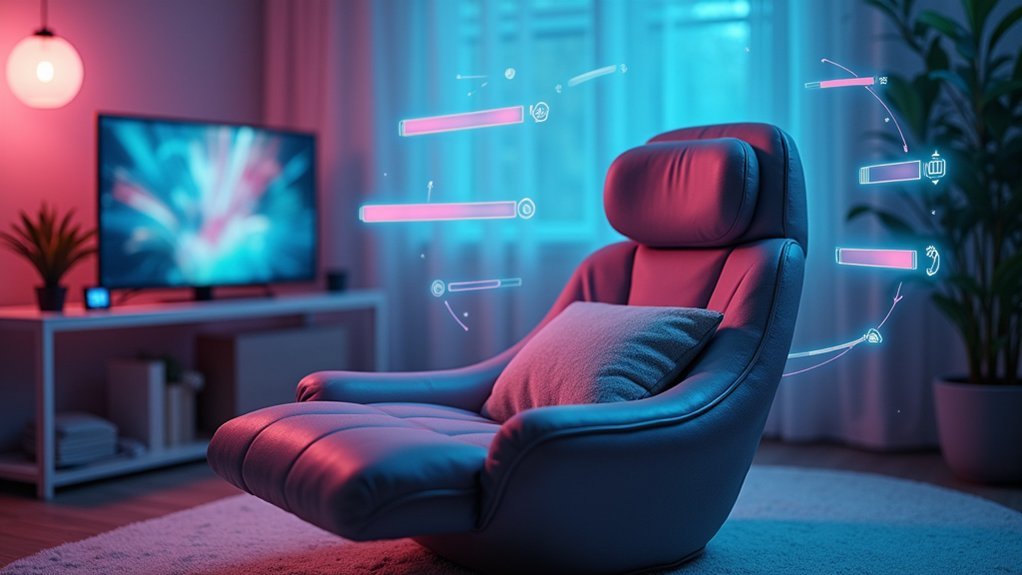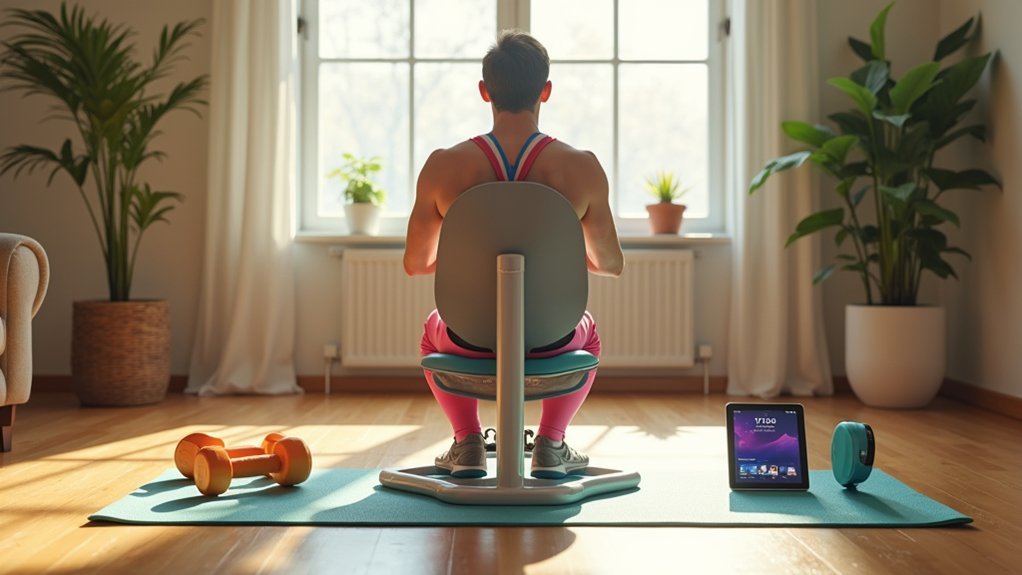You’ll discover transformative seated VR accessibility through adjustable point-of-view height settings that align avatars with your seated position, teleportation navigation eliminating physical movement requirements, and voice command controls reducing hand controller dependencies. Advanced gesture recognition accommodates limited mobility, while haptic feedback enhances spatial awareness and eye-tracking enables hands-free interaction. Audio spatial cues, adaptive wheelchair-inclusive avatars, and AI-driven personalization complete extensive accessibility solutions. These innovations create genuinely inclusive virtual environments that reveal VR’s full potential for your unique mobility needs.
Adjustable Point-of-View Height Settings for Wheelchair Users

While traditional VR experiences assume users can stand and move freely, adjustable Point-of-View height settings transform virtual reality into an inclusive medium for wheelchair users. You can customize your avatar’s perspective to match your seated position, creating natural interactions within virtual environments.
These settings accommodate various heights while reducing disorientation that often plagues users with mobility challenges. Research shows that adjustable POV height settings greatly enhance satisfaction for individuals requiring seated navigation.
You’ll find these features align with universal design principles, ensuring VR experiences remain usable regardless of physical abilities. By implementing accessibility in Virtual reality through customizable perspectives, developers create environments where you can engage comfortably without needing physical movement, making VR truly accessible for everyone.
Teleportation Navigation Systems Replacing Physical Movement
You’ll find teleportation navigation systems transform how you move through virtual worlds by eliminating the need for physical walking or standing.
Point-and-click teleport controls let you instantly jump to any location with simple hand gestures or gaze selection, while virtual comfort settings allow you to customize teleportation distance and speed to match your preferences.
These systems actively prevent motion sickness by removing the disconnect between your stationary body and virtual movement, making VR experiences comfortable and accessible from your seated position.
Point-and-Click Teleport Controls
When traditional VR movement schemes require users to stand, walk, or physically lean, point-and-click teleport controls eliminate these barriers by letting you navigate virtual environments with simple cursor selection. This accessibility feature transforms VR experiences for seated users, removing physical strain and movement limitations.
You’ll find teleportation systems offer several advantages:
- Customizable height adjustment – Teleport points automatically match your seated position for comfortable viewing angles
- Reduced motion sickness – Instant transportation eliminates the nausea often caused by smooth locomotion
- Enhanced exploration freedom – You can traverse vast virtual spaces without fatigue or mobility constraints
- Improved engagement – Seamless navigation keeps you focused on content rather than movement mechanics
These point-and-click teleport controls notably broaden VR accessibility, making immersive experiences available to users with diverse mobility needs and preferences.
Virtual Comfort Settings
Beyond basic teleportation mechanics, virtual comfort settings provide granular control over how you experience movement-free navigation in VR environments. You can customize teleportation distance, adjusting how far each jump takes you based on your physical capabilities and preferences.
Direction controls let you fine-tune orientation changes, preventing disorientation that often affects seated users.
These VR accessibility features considerably reduce physical strain and fatigue associated with traditional locomotion methods. You’ll find comfort options that accommodate prolonged seated sessions, eliminating the need for standing or walking movements that might cause discomfort.
Modern teleportation systems offer personalized settings that enhance spatial awareness while maintaining immersion. By tailoring these virtual comfort parameters to your specific needs, you’ll experience smoother navigation that keeps you engaged without physical limitations hindering your VR enjoyment.
Motion Sickness Prevention
Since traditional VR movement creates conflicting sensory signals between what your eyes see and what your body feels, teleportation systems eliminate this disconnect by replacing continuous motion with instant location changes.
This motion sickness prevention approach makes accessible VR experiences considerably more comfortable for all users.
Teleportation navigation offers several key advantages:
- Reduced nausea symptoms – You’ll experience fewer motion sickness episodes during extended VR sessions
- Enhanced mobility support – Users with physical limitations can navigate virtual spaces without movement challenges
- Improved user satisfaction – Studies show overwhelming preference for teleportation over traditional walking mechanics
- Broader accessibility – Individuals with balance issues can safely explore large virtual environments
These teleportation systems have become essential features in modern VR applications, making virtual experiences inclusive and comfortable for users who’d otherwise struggle with traditional movement methods.
Voice Command Controls Eliminating Hand Controller Dependencies
You’ll find voice navigation systems transform VR accessibility by letting you control environments through spoken commands instead of handheld devices.
When you can’t easily use traditional controllers, speech recognition technology becomes your primary interface for selecting menus, moving through spaces, and triggering actions.
The accuracy of modern speech recognition determines whether you’ll experience smooth, intuitive control or frustrating misinterpretations that break immersion.
Voice Navigation Systems
While traditional VR controllers can create barriers for users with limited hand mobility, voice navigation systems offer a powerful alternative that transforms how you interact with virtual environments.
These sophisticated systems utilize natural language processing to interpret your spoken commands, creating seamless navigation experiences that eliminate dependency on physical controllers.
Voice commands enable you to move through virtual spaces, select objects, and execute actions simply by speaking. This hands-free approach is particularly beneficial for improving accessibility among users with various mobility limitations.
Key advantages of voice navigation systems include:
- Customizable recognition for different accents and speech patterns
- Enhanced user satisfaction through intuitive interaction methods
- Streamlined navigation that maintains immersion quality
- Inclusive design accommodating diverse communication styles
These systems create more immersive experiences while ensuring VR remains accessible to everyone.
Speech Recognition Accuracy
The effectiveness of voice navigation systems depends heavily on speech recognition accuracy, which has reached impressive levels of up to 95% in modern VR applications. This speech recognition technology enables you to navigate virtual environments without hand controllers, making VR experiences truly accessible for seated users.
| Recognition Feature | Accuracy Level | Benefit |
|---|---|---|
| Basic Commands | 95% | Controller-free navigation |
| Accent Adaptation | 90% | Global accessibility |
| Speech Patterns | 88% | Diverse user support |
| Complex Instructions | 85% | Multi-step actions |
Advanced algorithms now differentiate between various accents and speech patterns, improving accessible design for diverse populations. You’ll find that voice commands reduce cognitive load by executing complex multi-step actions through simple verbal instructions. This creates a more immersive VR experience while accommodating speech impairments and enhancing overall usability.
Gesture Recognition Beyond Traditional Hand Movements

As VR technology evolves beyond traditional controller-based interactions, gesture recognition systems now capture a broader spectrum of human movement to create more inclusive experiences.
You’ll find that modern VR platforms can identify body movements, head nods, and facial expressions, providing multiple interaction pathways that don’t rely solely on hand gestures.
These advanced systems enhance accessibility for users with limited mobility:
- Adaptive gesture recognition accommodates slower, deliberate movements typical of users with physical disabilities
- Machine learning algorithms analyze diverse gesture patterns to support seated avatar interactions
- Voice command integration creates dual input systems for users who struggle with physical gestures
- Multimodal interaction methods combine gesture recognition with auditory cues for intuitive experiences
This thorough approach guarantees VR accessibility reaches users regardless of their physical capabilities.
Haptic Feedback Integration for Enhanced Spatial Awareness
Beyond visual and auditory cues, haptic feedback transforms how you experience spatial relationships in virtual environments by delivering precise tactile sensations that guide your navigation and interaction.
This technology makes VR more accessible by simulating textures and physical interactions that help you understand distances and obstacles around you.
Advanced haptic systems using ultrasonic waves or electrostatic forces create touch sensations without direct contact, perfectly suited for your seated position.
If you have visual impairments, haptic feedback becomes essential for effective navigation, providing spatial awareness through vibrations and tactile cues.
Research shows this integration improves your engagement and information retention in educational applications.
You’ll develop more intuitive understanding of virtual spaces, accurately delineating boundaries and objects through precise haptic feedback that enhances your overall VR experience.
Customizable User Interface Elements for Seated Positioning

You’ll need interface elements that adapt to your seated position rather than forcing you to stretch or strain to reach controls.
Adjustable menu heights let you position virtual interfaces at comfortable eye and hand levels, eliminating the physical demands of standard VR setups.
Seated avatar perspectives guarantee your virtual representation matches your actual position, maintaining immersion while accommodating your accessibility needs.
Adjustable Menu Heights
While standing users can easily reach standard VR menu elements, seated users often struggle with interfaces positioned at default heights that assume an upright stance.
Adjustable menu heights solve this problem by letting you customize interface positioning to match your seated perspective, creating a more comfortable and accessible experience.
These adaptive systems automatically adjust based on your height settings, guaranteeing menus appear within your natural reach zone. This inclusive design approach reduces physical strain while making navigation more intuitive.
Key benefits of adjustable menu heights include:
- Reduced physical discomfort during extended VR sessions
- Improved user satisfaction and engagement rates
- Compliance with accessibility guidelines for inclusive gaming
- Customizable positioning that adapts to individual needs
Modern VR developers increasingly prioritize these features to guarantee all users can fully engage with virtual content.
Seated Avatar Perspectives
How does your virtual avatar accurately represent your seated position in VR environments? Seated avatar perspectives require customizable interface elements that adjust your avatar’s height and perspective to match your actual seated position. This guarantees natural immersion while maintaining comfort during extended sessions.
Modern VR systems should offer wheelchair avatar options, making experiences accessible to people with mobility challenges. These representations provide authentic self-expression and eliminate barriers that traditional standing avatars create.
Key design considerations include adjustable eye-level positioning, proportional body scaling, and perspective calibration tools.
You’ll benefit from systems that remember your preferred settings across different applications. Advanced platforms also incorporate gesture recognition and voice commands, reducing reliance on hand controllers while maintaining full interaction capabilities within virtual environments.
Eye-Tracking Technology for Hands-Free Interaction
As virtual reality becomes more inclusive, eye-tracking technology stands out as a revolutionary solution that transforms how you interact with digital environments.
This hands-free approach eliminates traditional controller dependencies, making VR considerably more accessible for users with mobility impairments.
Eye-tracking technology creates truly interactive experiences through natural gaze patterns. You’ll discover intuitive control methods that respond to where you look:
- Object Selection: Simply look at items to select and interact with them
- Menu Navigation: Browse through options using eye movements alone
- Command Execution: Trigger actions by focusing on specific interface elements
- Immersive Control: Navigate virtual spaces without physical input devices
Leading companies like Tobii and Pupil Labs are developing sophisticated eye-tracking solutions that integrate seamlessly into VR systems, promoting inclusive design for all users.
Audio Spatial Cues and Enhanced Immersive Sound Design
When you’re seated in a virtual environment, audio spatial cues become your primary navigation compass, transforming how you perceive and interact with digital worlds.
3D sound technology creates realistic auditory landscapes that let you pinpoint the exact direction and distance of sounds around you, enhancing both immersion and spatial awareness.
Immersive sound design incorporates binaural audio techniques that mirror natural human hearing, greatly improving your orientation and movement capabilities.
You’ll find this particularly valuable when visual cues aren’t accessible or sufficient for navigation.
Voice commands integrated with spatial audio create intuitive interaction pathways, while calming ambient sounds reduce anxiety for users with autism.
This thorough audio accessibility approach guarantees you can engage meaningfully with VR environments regardless of physical limitations or sensory preferences.
Adaptive Avatar Representation Including Wheelchair Options
Beyond creating immersive soundscapes, your virtual presence itself plays a fundamental role in accessibility and inclusion.
Adaptive avatar representation transforms VR from a limiting experience into one that truly reflects your identity and needs. When platforms offer wheelchair options, you’ll experience enhanced engagement and belonging that accurately mirrors your real-world mobility.
True VR inclusion means avatars that reflect your real identity and mobility, creating belonging rather than barriers in digital spaces.
Key benefits of adaptive avatar representation include:
- Customizable mobility features that let you adjust avatar appearance to match your physical needs
- Point-of-view height adjustments for comfortable navigation in virtual environments
- Improved self-esteem and social interaction through accurate representation of your experience
- Broader accessibility compliance that makes VR platforms inclusive and accessible to diverse users
This inclusive approach doesn’t just meet accessibility standards—it expands VR’s potential audience while creating genuinely welcoming digital spaces.
AI-Driven Personalization for Individual Mobility Needs
While adaptive avatars provide visual representation, AI-driven personalization takes accessibility further by learning your specific mobility patterns and automatically adjusting VR experiences to match your unique needs.
Machine learning algorithms analyze your behaviors and preferences, identifying accessibility requirements like ideal avatar height or preferred navigation methods for seated use.
You’ll benefit from enhanced gesture recognition that accommodates mobility limitations through voice commands or minimal physical movements.
AI systems generate personalized content recommendations, ensuring you access engaging experiences suited to your capabilities.
These VR technologies continuously improve through real-time adjustments, creating dynamic environments that respond to your mobility challenges.
This intelligent adaptation transforms virtual reality into truly inclusive spaces that evolve with your individual needs.
Frequently Asked Questions
Can You Play VR While Seated?
Yes, you can play VR while seated. Many games support seated gameplay with teleportation navigation, adjustable avatar height, and voice commands. Developers design seated-friendly interfaces to guarantee you’ll have comfortable, immersive experiences without standing.
How to Make VR Accessible?
You’ll create accessible VR by implementing adjustable avatar heights, seated navigation options, alternative gesture controls, audio cues with captions, and conducting regular testing with disabled users for feedback-driven improvements.
How Can VR Help People With Disabilities?
VR helps you access previously unreachable environments and activities. You’ll connect with others socially, reducing isolation. You can learn at your own pace through customized education and improve motor skills through therapeutic rehabilitation programs.
How Can a User Increase a Virtual Reality VR Headsets Positional Accuracy in Room Scale?
You’ll improve your headset’s positional accuracy by ensuring proper lighting, calibrating your play space correctly, updating firmware regularly, maintaining clear sensor sight lines, and adding external tracking stations when possible.





Leave a Reply